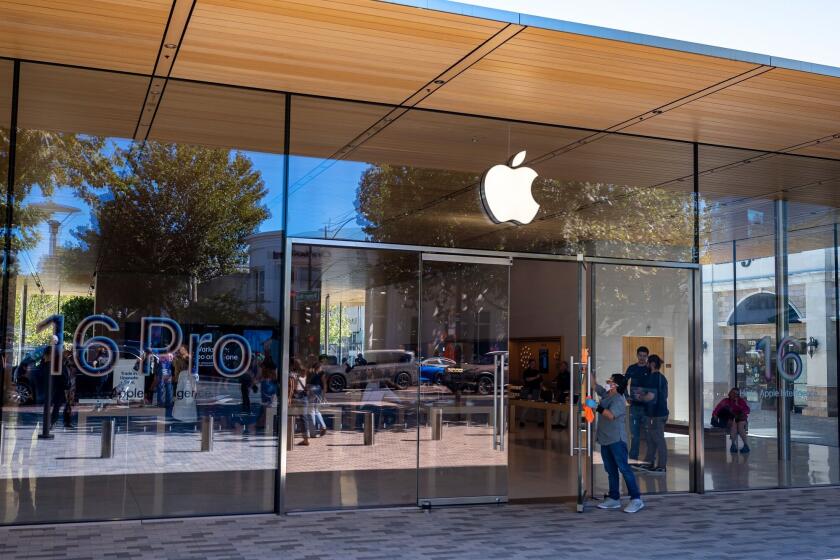Consumers’ Rate Cuts Had Already Come
- Share via
Tuesday’s Federal Reserve Board rate cut may have little immediate impact in lowering interest rates on consumer loans and savings, but that’s largely because those rates had already fallen substantially, well ahead of the Fed move.
Powerful market forces--including competition and recent widespread anticipation of a Fed easing--have resulted in some of the lowest rates in years for credit cards, mortgages and small-business loans.
Meanwhile, yields on bank savings accounts and certificates of deposit have also fallen recently, although less dramatically.
In Wall Street parlance, the Fed is “behind the curve” with its rate cut: Yields on U.S. Treasury securities, the benchmarks for many other market rates, have been sliding for months as investors have bet that a slowing global economy would force U.S. rates lower.
That has helped push home mortgage rates lower, fueling a strong market for housing and allowing many homeowners to refinance their mortgages at significant cost savings. In that sense, expectations of a Fed rate cut have already played a significant role in stimulating the economy and boosting the fortunes of many consumers.
Bill and Lynn Kepp of Glendora are an example of consumers saving money. The couple are on track to save more than $150 a month with the mortgage refinancing they started two weeks ago.
“We’ll be socking more away for retirement,” Kepp said.
The true importance of the Fed’s cut Tuesday in its key short-term interest rate, to 5.25%, is that it may signal additional cuts in coming months and into 1999--the extent of which may not fully be reflected in the marketplace today.
That could ultimately mean much lower borrowing costs. But experts also warn that significantly lower rates probably would occur only in tandem with a deep economic slowdown--or recession.
In the near term, loan costs and savings rates could notch a bit lower if banks respond to the Fed’s small move by lowering their so-called prime lending rate, a benchmark used to determine costs for credit cards, home equity loans and small-business loans.
Virtually all lenders have so far been reluctant to lower their prime rates. Among major U.S. banks, only two--Norwest Corp. and U.S. Bancorp, both based in Minneapolis--on Tuesday announced a quarter-point prime rate cut, to 8.25%.
Industry officials were mixed about whether a general prime rate drop could come this week, with some predicting more banks announcing moves today and others saying banks may wait for another Fed rate cut later this fall.
Some bankers argue that the prime rate has become less important in recent months, as lenders have changed the way they calculate loan costs.
Rates on many credit cards, home equity loans and some business loans have dropped in the last year as lenders have chosen to narrow the difference, or “spread,” between loan rates and the prime, said James Chessen, chief economist for the American Bankers Assn., a trade group based in Washington.
Rising competition among lenders and steep declines in bond yields helped contribute to the drops, he said.
“It used to be home equity loans were 2 percentage points above prime. Now a borrower with great credit can get a home equity loan at prime,” Chessen said.
The average home equity loan rate is now 9.32%, a drop of 0.21 percentage point from a year ago, according to Bank Rate Monitor.
Those kind of adjustments may mean banks are less responsive when the Fed finally makes interest rate changes, Chessen said.
Still, if the Fed further eases its benchmark rate in coming months, the prime and other loan rates are almost certain to fall further--benefiting consumers and businesses.
Sixty percent of the nation’s $438 billion in credit card balances are tied to the prime, as are many home equity lines of credit and small-business loans.
A quarter-point drop in the prime could save consumers more than $600 million over the next year in credit card interest alone, said Robert McKinley, president of Gettysburg, Pa.-based CardWeb Inc. and publisher of CardTrak, a newsletter that monitors credit card trends.
The potential effect of further Fed rate cuts on mortgage rates--already at 30-year lows--is harder to predict.
Mortgage rates have traditionally tracked the 10-year U.S. Treasury note rate, not short-term market rates. Yet lately, even the Treasury note connection has frayed. While mortgage rates have tumbled, they have fallen far less than 10-year Treasury rates have declined.
Mortgage rates “should be three-quarters to 1 percentage point lower than they are,” said Monica Williams, treasurer of Los Angeles-based Sanwa Bank.
Mortgage rates are higher than they might otherwise be because investors who buy mortgages are less willing to accept lower rates, said Brian Carey, an economist with the Mortgage Bankers Assn. in Washington.
Most home mortgages are packaged into securities and sold to investors, and the risk of prepayments from widespread refinancing has led investors to demand better returns, Carey said.
What’s more, many economists argue that Treasury rates have been artificially depressed by the global “flight to safety,” as fearful investors have flocked to Treasuries. If that flight were to ease, Treasury rates could conceivably rise again--and with them, mortgage rates--especially if investors were to believe that the Fed’s rate cuts will promote faster economic growth.
Meanwhile, holders of adjustable-rate mortgages are unlikely to see much immediate change because of the Fed move, even though most of these loans are tied to short-term rates.
The reason is that the loans’ primary benchmarks, including the one-year Treasury bill rate, have already fallen. The one-year Treasury yield was unchanged at 4.52% on Tuesday, down from 5.44% a year ago.
Only about 20% of the nation’s mortgages have adjustable rates, and many new adjustable mortgages are issued with introductory fixed rates for three, five, seven or 10 years, making them impervious to short-term rate changes, the MBA’s Carey said.
As for savers, yields on bank savings and money market investments have fallen only modestly in recent months.
The average yield on a one-year certificate of deposit is 4.91% now, down from 5.17% a year ago, according to Bank Rate Monitor.
Rates paid on savings depend in large part on competition and banks’ need for money to make loans.
Still, if the Fed is about to embark on a concerted campaign to lower short-term interest rates, it is likely that money market rates and bank CD yields also will slide in coming months, experts say.
More to Read
Inside the business of entertainment
The Wide Shot brings you news, analysis and insights on everything from streaming wars to production — and what it all means for the future.
You may occasionally receive promotional content from the Los Angeles Times.










